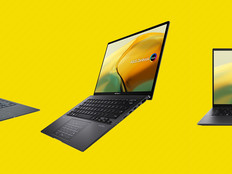Snappy Scanner
The ScanSnap S300 is a very friendly, simple device. The unit has only one button, which sends the scan directly to the computer. At slightly more than three pounds, the S300 might not be the smallest or lightest device of its type, but it’s portable enough so that most people can carry it with their notebooks. And for its size, it’s among the smallest automatic document feeders (ADF) with duplex capability.
The S300 turns on when you open its cover, which can be extended to support longer pages. One drawback is that there’s no retractable tray to collect pages after they have been scanned. Putting the scanner in the middle of a table solves this.
One of the most interesting design and hardware features on the S300 is its ability to charge directly using a USB connector — actually, two USBs: one for power and one for data. Using a USB for power increases the scanning time -- (about seven seconds more for each page on our test), independent of the resolution selected. Using the USB to charge the S300 makes it a truly portable device, although it still requires a computer.
The S300 also has an ADF that can hold up to 10 pages at a time. This is a very important feature for day-to-day use, and the fact that you can load several pages, go out for a minute or two, and come back when the work is done is a tremendous advantage.
S300 Software
The software package that comes with the S300 includes several applications, such as ScanSnap Manager, ScanSnap Organizer and CardMinder, [PPP] intended to help users organize their scanned documents, pictures and business cards. Unlike many instances where an otherwise decent piece of hardware is crippled by poor software implementation, the software that comes with the S300 is pretty solid, though somewhat limited.
The ScanSnap Manager, used to tune the various settings of the S300 and perform the scan, is a straightforward, no-nonsense utility. For the average businessperson, the fairly limited nature of this utility could actually be a blessing, as the software can scan and convert a document into a PDF file with the press of a single button, either on the computer or on the scanner. This one-click-to-PDF feature worked flawlessly in my tests.
On the other hand, for the power user, the simple nature of the software might be an issue. Scans can be saved only as JPEG files — and only when scanned in color mode. The ScanSnap Manager doesn't have any of the features you expect to find on a standard flatbed scanner, such as adjustable color, sharpness or resolution (although there are four predefined resolutions).
The ScanSnap Organizer, as its name implies, functions as an image and document file organizer. This software is a nice addition but certainly not a necessity, because users can choose among several available image-organizer utilities to help them organize and store their scans once they are saved on the computer.
Other functions of the software, such as scan-to-print, scan-to-folder and scan-to-e-mail, worked flawlessly in our test, although scanning business cards in order to print them required fairly high DPI to reproduce small letters.
Optical Character Recognition
The S300 software has two features based on optical character recognition (OCR): the ability to turn PDFs into searchable PDF files, and business-card data recognition.
When I first tried the searchable-PDF function, I ran into some trouble. Apparently, Fujitsu didn't program the software to change the output-file format of a document into PDF when the searchable-PDF format is chosen. Because our previous scans were in JPEG format, the software did not know what to do and crashed several times. Eventually, I changed all the settings and fixed the issue.
Creating a searchable PDF using various documents in English also resulted in very acceptable searchable files. Searchable PDF files are slightly larger (a few hundred kilobytes more), and using Adobe Reader, I was able to search for words across the document with pretty good accuracy.
The S300 uses Abbyy FineReader’s OCR engine; however, Fujitsu chose the now-outdated version 7 (in March 2008, ABBYY released version 9). This older version created problems when I tried to use OCR on text with less than normal contrast (for example, white text on a green background, instead of black text on a white background, which worked fine).
The severity of this OCR contrast problem was especially apparent in the second feature that uses the OCR engine: CardMinder, the business-card scanner utility. After scanning close to 200 business cards, between 70 to 80 percent of the scans produced accurate results, with names, e-mails, addresses and phone numbers correctly recognized by the OCR engine. The remainder were either only partiality recognized or not recognized at all. The contrast issue is likely the reason for the problem, and scans of business cards with color backgrounds resulted in poorly recognized text.
At the end of the day, the S300 is close to being the ultimate portable scanning device. It's extremely fast, has literally no startup or warming time, and produces good scans on its maximum resolution (600 DPI) and decent scans at lower resolutions. It has an extremely useful duplex capability and an even more useful 10-page ADF.
The S300 is very simple to install and use, and the one-button-to-PDF feature is a great addition for increased office productivity. The business-card scanning feature works very well. At 80 percent accuracy, the bundled OCR is not perfect, but its ease of use and simple integration with external software such as Microsoft Outlook usually compensates for that.
Although the S300 is not the smallest or lightest portable scanner currently on the market, its electric flexibility and ability to connect directly to a notebook with 2X USB instead of a power outlet gives it an advantage. Retailing at $300, the S300 isn't the cheapest on the block, but given its quality and duplex capability, the price seems more than reasonable.






